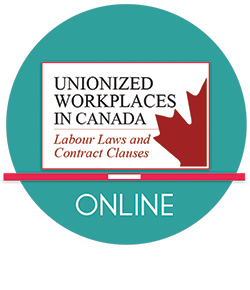Unionized Workplaces in Canada

Collective bargaining is recognized by the Supreme Court of Canada as a cornerstone of our democratic society, protected by the guarantee of freedom of association in the Charter of Rights and Freedoms. Its importance cannot be overstated. According to Statistics Canada, the number of employees covered by collective agreements in 2014 was 4.7 million, 31.5% of the total number of employees in Canada. In any given year, thousands of sets of negotiations take place across the country in both public and private sectors.
Unionized Workplaces in Canada: Labour Laws and Contract Clauses reflects the results of those negotiations, reproducing as it does some 1,700 clauses, drawn from current collective agreements, in a number of subsectors, that touch upon a variety of topics. These clauses are accompanied by surveys of applicable legislation and commentary on arbitration cases and judicial decisions.
In selecting clauses for inclusion, we have been guided by several criteria. Priority has been given to provisions that are representative, accommodative, and on occasion innovative. While it is hoped that the clauses which are included do justice to the range of solutions that have been devised in order to reconcile the differences that commonly arise between the parties, there is, we recognize, no limit to such solutions and we invite users of this service to forward to us at collectiveagreements@lancasterhouse.com additional clauses of interest for inclusion in future updates.
The completion of this work, the fourth edition of Unionized Workplaces in Canada: Labour Laws and Contract Clauses, has proved to be a challenge. What began as a 100-page primer in 1977 evolved into a 500-page hardcover volume in 1985, and then into a 900-page loose-leaf service in 1996. In its present online format, it consumes the equivalent of 2,000 printed pages, which are now, thanks to the powerful Presto platform hosted by Lucidea, instantly searchable in a variety of ways. The sheer scope of the undertaking has required the joint efforts of some seven lawyers, working consistently over a period of more than three years, to bring it to fruition. The service will not be allowed to languish; in order to ensure that it remains current, it will be regularly updated.
The clauses in this service have been selected from a wide variety of sources, including online collections of the federal and provincial labour ministries. The federal government’s database, Negotech, contains some 8,000 current collective agreements. Provincial ministries of labour add to that number. In this regard, we are grateful to the staff at Negotech (http://negotech.labour.gc.ca/cgi-bin/search/negotech/search.aspx) and Ontario’s Collective Bargaining Information Service (http://www.sdc.gov.on.ca/sites/mol/drs/ca/Pages/default_en.aspx) for their willingness to assist in the furtherance of this project.
Finally, we wish to express our appreciation for the assistance provided by our colleagues and co-authors: Boris Bohuslawsky, Lauren Brecher, Paula Chapman, Chris Davidson, Meryl Gary and Michelle Johnston. We are grateful, too, for the contribution of Carly Ferrier, law clerk par excellence, who worked above and beyond the call of duty. Thanks also go to Hugh Mackenzie, a leading Canadian economist, for his review of the section on cost-of-living allowances, and to Rafael Gomez, Director of the Centre of Industrial Relations and Human Resources at the University of Toronto, for his revision of the section on job evaluation.
We hope that this service will contribute to the quality of collective bargaining in Canada. That has been our aim.
Jeffrey Sack, Q.C.
Peter Neumann

